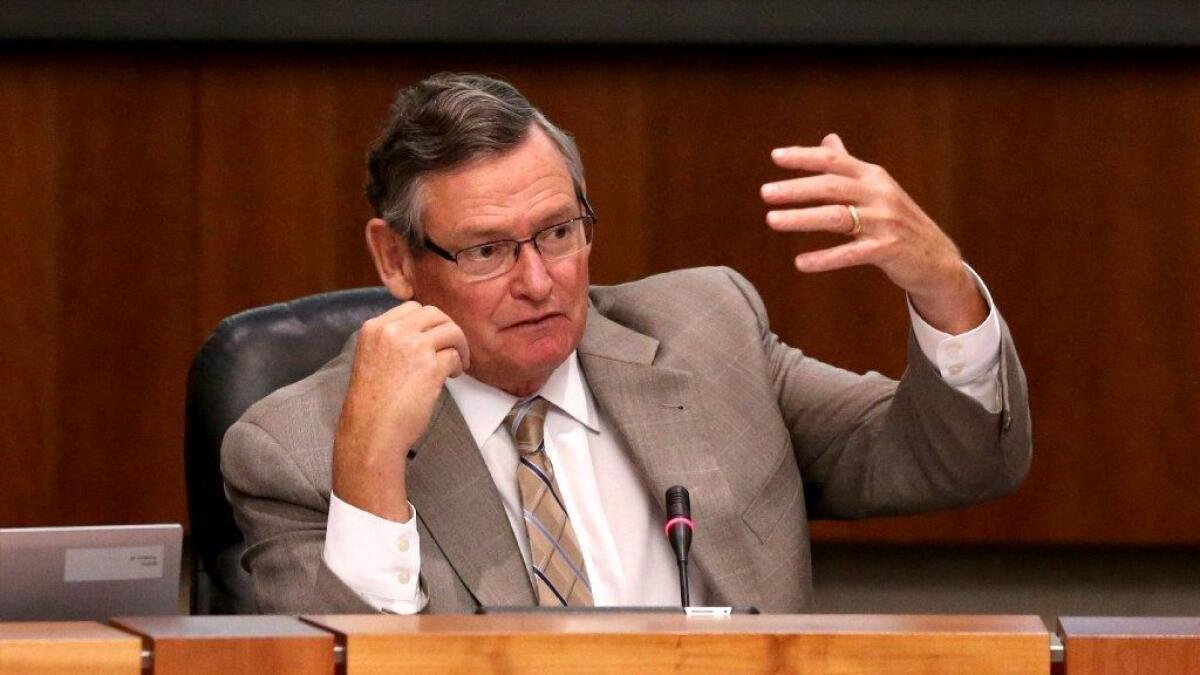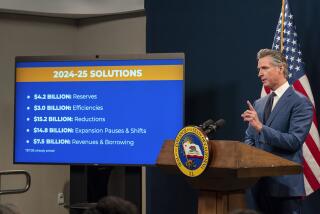With few budget solutions in sight, Cal State administrators say another tuition increase is possible

California State University faces difficult budget problems with no quick solutions, and administrators are preparing for tuition increases, program cuts and other unpopular options that seem unavoidable.
Gov. Jerry Brown’s 2018-19 budget plan, released earlier this month, proposed a fraction of what administrators say they need in state funding to support the nation’s largest public university system. The system’s 23 campuses are under pressure to enroll more students and graduate them faster, while also keeping up with faculty salary demands and a $2-billion building maintenance backlog.
Chancellor Timothy P. White is expected to address these issues Tuesday in his annual state of the university address during a Board of Trustees meeting in Long Beach. The state covers a smaller proportion of Cal State’s costs than it used to, and the number of students who want to attend exceeds campus abilities to accommodate them. Last fall, Cal State had to turn away about 31,000 fully qualified students. Total enrollment has grown to more than 484,000 students.
Looming over the meeting is a controversial proposal to raise tuition by $228 for in-state students, bringing the annual cost to $5,970. Full-time nonresident students would see tuition increase by about $900, bringing the annual total to $12,780. It would be the second consecutive increase after a six-year freeze on tuition hikes.
The University of California, facing similar budget pressures, is also considering a tuition increase. After student protests and a heated debate, regents last week voted to put off a decision until May in order to step up pressure on the Legislature to increase state funding for the university system.
Discussions at Cal State are expected to also be difficult. Trustees in a November meeting expressed dismay at the possibility of another tuition increase.
“Trustees will not be asked to raise tuition, if it becomes necessary, until at least May,” White said Monday, acknowledging the mounting concerns in recent days. “This will allow all to gain a deeper understanding of the state’s financial outlook, make our case to policymakers and recognize the efforts undertaken to streamline operations across the university.”
But the financial options are limited, administrators said. Based on Brown’s current budget plan, administrators expect to get only $92.1 million of the $263 million they say they need in additional state funding — which would bring Cal State’s total annual operating budget to $6.8 billion. They said $39.9 million of the additional funding they are seeking would be used to enroll the equivalent of 3,641 additional full-time students, and $75 million to continue efforts to double the four-year graduation rate to 40% by 2025 (an ambitious undertaking that is estimated to cost $450 million in total).
Employee healthcare and other mandatory costs alone would eat up most of the additional funding. A tuition increase, according to a proposal submitted to the Cal State Student Assn., would generate $90.5 million in new revenue, after taking into account additional financial aid costs.
Lobbying state lawmakers for more funding is still the top priority for the next few months, administrators said. Without either additional state funding or tuition revenue, trustees and campus leaders would have to make some tough calls.
“The possibility for campus budget reductions is real,” according to a report prepared for trustees by Cal State’s chief financial officer and assistant vice chancellor for budget. “This includes the availability of fewer course sections, a decrease in student enrollment, fewer students receiving financial aid, limits to academic counseling and psychological well-being counseling services, and negative impacts on the operations and maintenance of central plant facilities.”
Students and faculty say they are frustrated with the yearly budget impasse — which many say avoids dealing with long-term, systematic funding problems.
“This is déjà vu all over again. As we have seen so many times before, rather than push back, the administration offers ways to ‘adjust’ to the governor’s proposal, which always means that students pay more and get less, and thousands of others get nothing because they are turned away,” said Lillian Taiz, professor emerita at Cal State L.A. and a member of the California Faculty Assn.
Trustees will also discuss proposals on how to accommodate more students and redirect them to less crowded Cal State campuses. While Cal State has increased enrollment by 31,000 full-time equivalent students since the recession — the equivalent of two new campuses — demand continues to outpace capacity.
Six of Cal State’s 23 campuses — Fresno, Fullerton, Long Beach, San Diego, San Jose and San Luis Obispo — are so popular that every major and program has had more qualified students applying than can be accommodated by faculty, staff and campus resources.
The trustees are scheduled to meet for two days. A livestream of the open sessions can be viewed here.
Follow @RosannaXia for more education news
More to Read
Sign up for Essential California
The most important California stories and recommendations in your inbox every morning.
You may occasionally receive promotional content from the Los Angeles Times.











